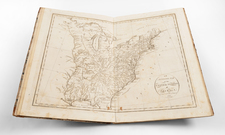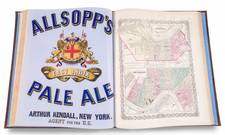The Earliest Obtainable Atlas Printed In Arabic.
Lithographed world atlas published by the Church Missionary Society Press in Malta in 1835. This is the second, enlarged and expanded, edition of the first Arabic printed atlas ever produced, and the only edition that a collector or institution might reasonably hope to obtain.
First Arabic Atlas
Cartographic publishing in the Muslim world was largely stifled by Ottoman proscriptions on printing until well into the 19th century. There were a few instances of atlases being published earlier, such as the Celebi and Cedid atlases, and of the Hajji Ahmed Mappamundi, which was published in Venice with the never-realized intent to export it to Ottoman Empire. However, those works were all printed in Ottoman Turkish, not Arabic. Malta, with its close proximity to the Arab world and Ottoman Empire, but its status as a Crown Colony, was a natural place for the first Arabic atlas to be published.
As Geoffery Roper notes (page 328):
...and what was true of diagrams was equally true of printed maps, in which field the Malta atlas of 1833 and 1835 also broke new ground. In Tunisia the first atlas was printed in 1860, in Egypt regular Arabic map printing did not begin until 1870, although copies of the Malta atlas itself were made there at an earlier date...
While the 1833 atlas was the first, it is unobtainable today. One copy is known in the Albert Ganado Melitensia Collection, and one more was recorded by C. L. Dessoulavy in the British Museum.
Although it was not printed in large numbers, the atlas had an impact in the Arab world. It was quickly reproduced in Egypt. Lord Lindsay wrote from Cairo in December 1836: “perhaps the most useful work the Pasha has published is an Atlas in Arabic. Copied from one, the missionaries have executed at Malta” (Roper, page 252).
The Genesis of the Atlas
In their book, The Brocktorff Mapmakers, Albert Ganado, Joseph Schiro, and Claude Micallef Attard provide an excellent overview of how the Arabic atlas came to be published:
When the Anglican Church Missionary Society decided to establish a Mediterranean Mission in 1815 to evangelize the peoples of Southern Europe, North Africa and the Middle East, they directed their attention to Malta which occupied a central position in the Mediterranean and so geographically lay on the main communication and trading routes between east and west and north and south. The C.M.S. immediately appointed Dr Cleardo Naudi, a Maltese Professor of Chemistry, at the University of Malta, as their correspondent in Malta and sent William Jowett in 1815 to go to the Mediterranean and the Middle East to study the different religious communities and to formulate plans for ‘propagating Christian knowledge’ among them.
After nine years sojourning and travelling in the Eastern Mediterranean, Jowett concluded by emphasizing the importance of education first, before trying to spread the evangelical message, and he felt it very important that the C.M.S. should provide a range of educational books by creating a printing establishment. Malta offered the best advantages for such an undertaking. The Committee of the C.M.S. were impressed with Jowett’s reports and pledged their support but after many delays in the procurement of Arabic and Greek founts [sic?] and other equipment, the first Arabic books came out only in 1827. However the C.M.S. Press initially faced many problems with their setters and printers as they had no knowledge of Arabic. This changed when Christoph Friedrich Schlienz (1803-68) who was born in Kirchheim in Württemberg joined the C.M.S. Press in Malta and eventually became its Superintendent. With the aid of Matthäus Weiss, the C.M.S. printer in Malta, and George Percy Badger and Fāris al-Shidyāq acting as translators into Arabic and editors of the Arabic script, the C.M.S. published most of the Arabic books in Malta between 1827 and 1840. Besides, it results from the Malta Government Accounts for 1831 that an allowance of £30 was being paid to a student in Asia Minor to study Arabic, and in 1832 an allowance of £70 was paid to a gentleman abroad to perfect himself in the Arabic language.
When in 1832 Schlienz discovered that a German lithographer was living in Malta, he immediately contracted two of his sons, Frederico and Luigi [Brocktorff] as lithographers, and Francesco, another son, as a binder.
The C.M.S. took a pioneering role in the introduction of printing in the Arab world... However although the output of printed works was impressive, the distribution of books was weak and with mounting debts the C.M.S. printing press had to close down in 1842 and was eventually bought by Matthäus Weiss.
Complement of Maps
-
[Map of the World, Western Hemisphere]
-
[Map of the World, Eastern Hemisphere]
-
[Map of Europe]
-
[Map of Russia]
-
[Map of Africa]
-
[Map of North and South America]
-
[Map of Australia]
-
[Map of North Africa]
-
[Map of Asia]
-
[Map of Asia]
-
[Map of Eastern Mediterranean]
Rarity
According to our research, the 1835 Arabic atlas has not previously been offered publicly for sale. We find records of the following institutional holdings: National Library of Australia; Osterreichische Nationalbibliothek; SOAS, London; National Library of Qatar.
References
Albert Ganado, Joseph Schiro, Claude Micallef Attard. The Brocktorff Mapmakers. Malta: BDL Publishing, 2012
Geoffrey Roper, Eva Hanebutt-Benz, Dagmar Glass, eds. in collaboration with Theo Smets, Middle Eastern Language and the print Revolution: A Cross Cultural Encounter. Westhofen, 2002.
Geoffrey Roper. Ph.D. dissertation: “Arabic Printing in Malta 1825-1845 - Its History and Its Place in the Development of Print Culture in the Arab Middle East”, University of Durham, 1988.











![[Fifteen Admiralty Charts of the South Coast of England]](https://storage.googleapis.com/raremaps/img/small/92093.jpg)
![[Two Rare Germany Regional Atlases] Neuer Indemnisations- und Grenz-Atlas von Teutschland : in 12 speciellen illuminirten Blättern, welche die neuen Besitzungen der Chur- und Fürstlichen Häuser und der Reichsstädte, nebst den Entschädigungen nach dem definitiven Reichs-Deputations-Schlusse vom 25ten Febr. 1803 enthält. [and] Hand und Staats Atlas vom dem Churfurstenthum Sachen und dem Herzoglich Sachischen Landern in 16 Speciellen Blattern . . .](https://storage.googleapis.com/raremaps/img/small/69508.jpg)
![[Cyclist Atlas]](https://storage.googleapis.com/raremaps/img/small/88491.jpg)


![[ London ] An Exact Survey of the City's of London Westminster ye Borough of Southwark and the Country Near Ten Miles Round Begun In 1741 & Ended in 1745 By John Rocque Land Surveyor & Engrau'd By Richard Parr / A New and Accurate Survey Of the Cities of London and Westminster The Borough of Southwark with The Country about it for nineteen Miles in Length and thirteen in Depth . . .](https://storage.googleapis.com/raremaps/img/small/96431.jpg)